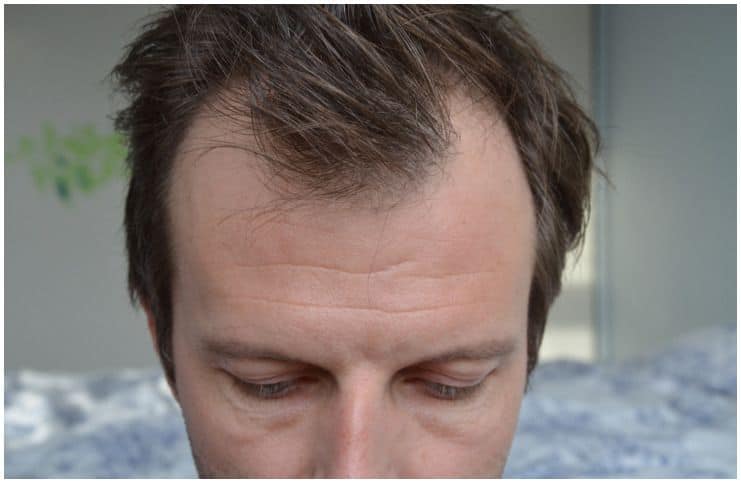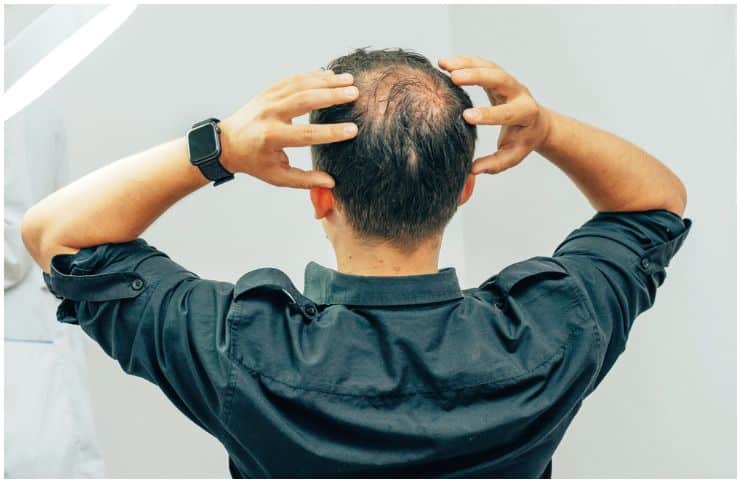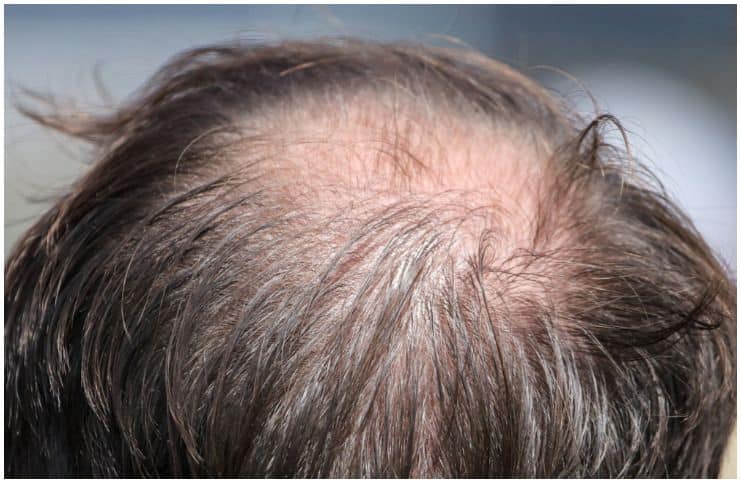Telogen Effluvium vs Male Pattern Baldness – Symptoms, Causes, Differences:
Telogen effluvium (TE) is the 2nd most common form of hair loss diagnosed by dermatologists. However, unlike some other scalp and hair conditions, it is temporary, and the hair growth usually recovers.
TE happens when there is a notable change in the actual number of hair follicles that are growing hair.
For instance, at any given time, about 15 percent of the hairs on the average individual’s head are resting (this is considered the telogen phase), and the other 85 percent are actively growing (this is considered the anagen phase).
If the number of hair follicles producing hair stops considerably for any cause during the resting phase, there will be an increase in dormant, telogen-stage hair follicles. This results in TE hair loss.
While this condition is usually limited to the scalp, in more serious cases, it can affect other areas, such as the pubic region or eyebrows.
It can affect all age groups and both genders equally and is not inherited. Furthermore, it is thought that most adults have experienced an episode of TE at some point during their lives, especially early in life.
Types
Acute TE is described as hair shedding lasting less than 6 months. Individuals with acute TE typically complain of relatively sudden onset of hair loss.
Chronic TE may last for a more extended period of time and is generally caused by ongoing factors, plus, it may not go away until those underlying factors are resolved.
Symptoms
Common symptoms may include:
- a change in the density of the scalp;
- a build-up of hair in the hairbrush, shower, bath, or pillowcase (especially in the morning).
Note – the amount of hair loss varies from day to day.
For example, on some days, 40-50 hairs will be lost, whereas, on other days, over 300 hairs may be lost.
Causes
There are many potential causes for TE; however, this condition is usually experienced when the following occurs:
- extreme weight gain;
- extreme weight loss;
- hyperthyroidism (overactive thyroid gland);
- hypothyroidism (underactive thyroid gland);
- childbirth;
- nutritional deficiencies (anemia);
- severe fever;
- side effects of some prescription or non-prescription medicines;
- major surgical procedures;
- emotional stress;
- physical trauma;
- andropause;
- menopause.
Treatment
There is no treatment needed for this condition, as the hair will start growing by itself if the trigger is eliminated.
Some treatments may prove helpful to reduce the amount of shedding your experience, and they include:
- platelet-rich plasma therapy;
- minoxidil 5% lotion applied every day;
- biotin (a water-soluble vitamin which is a part of the vitamin B-complex);
- L-lysine (an amino acid)– 500 mg tabs used twice per day;
- nutrition changes to correct possible nutritional deficiencies;
- low-level laser therapy.
Prevention
One method of prevention is “clean” eating which includes avoiding chemicals, hormones (especially from dairy products), toxins, cholesterol, and trans fats.
Also, individuals who have a deficiency in zinc have a higher chance of this condition.
Emotional stress has also been shown in many studies to trigger the onset of this condition as well as it and may worsen signs and symptoms over time.
To reduce your stress levels, it is recommended to practice moderate physical exercise (such as running or cycling), mindfulness meditation, Tai Chi, yoga, plus healthy sleeping patterns.
Male Pattern Baldness (MPB)
Also referred to as androgenic alopecia, it is the most frequent type of hair loss in men.
It usually begins with hair loss above the temples generating the “M” shape. As time passes by, only a rim of hair is left around the sides and back of the scalp.
Ultimately, the loss of hair continues and claims the hair on the sides and rear of the head as well, leading to an entirely bald scalp.
Even if a man could start experiencing MPB at an earlier age, the hair loss becomes more severe as he grows older.
For instance, about 50% of all men over the age of 50 will be affected by MPB to some extent, according to the U.S. National Library of Medicine.
Causes
The leading cause of MPB is the secretion of a hormone known as dihydrotestosterone (DHT). The higher the dihydrotestosterone generated by the body, the more hair is lost.
In addition, genetic factors may increase the likelihood of MPB.
Note – MPB is not a sign of a life-threatening medical condition; however, it has been associated with some other conditions, like – an enlarged prostate, coronary heart disease, diabetes, prostate cancer, hypertension, and obesity.
Treatment
In the present day, there are few available treatment methods to halt MPB, with the following treatments being proven to be successful:
- Minoxidil – it was the 1st drug approved by the US Food and Drug Administration
for the treatment of MPB; - Finasteride – it is the generic name for the brand name drugs Propecia and Proscar. Its side effects of hair growth were found during the development of a medicine to treat enlarged prostate glands.
Prevention
MPB is not a result of stress. Nevertheless, emotional stress can lead to increased hair loss.
Good and effective ways to reduce your stress levels include – spending time in nature, mindfulness meditation, physical exercise, and healthy sleeping patterns.
Because nails and hair are considered non-essential by the body, lacking the right nutrients in your regular diet may lead to brittle nails and thinning hair.
Moreover, it is vital to avoid foods that are high in hormones, trans-fats, or cholesterol since men with type 2 diabetes and hypertension have increased chances for MPB.
Telogen Effluvium vs Male Pattern Baldness – Differences
TE is a temporary condition that may occur at a time, and once the cause is eliminated, the hair starts to grow back again.
On the other hand, MPB may begin in the 20s and ”works” non-stop until a man is completely bald. It accounts for more than 95 percent of hair loss in men.
READ THIS NEXT:
Oral Gonorrhea vs Strep Throat
References https://www.ncbi.nlm.nih.gov/pubmed/15692504 https://www.sciencedaily.com/releases/2017/02/170214162735.htm https://www.ncbi.nlm.nih.gov/pmc/articles/PMC4606321/ http://journals.plos.org/plosgenetics/article?id=10.1371/journal.pgen.1006594



